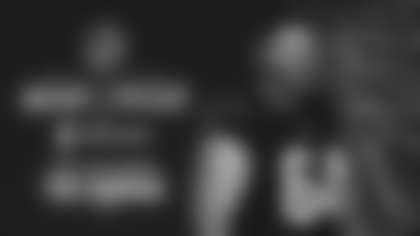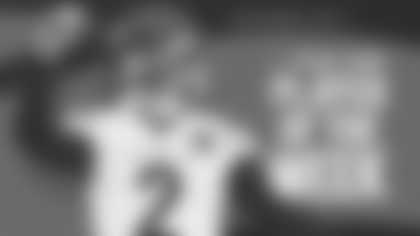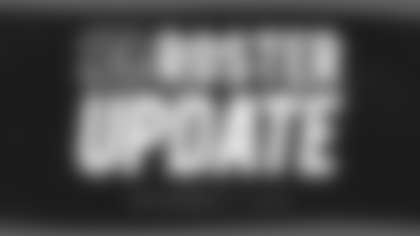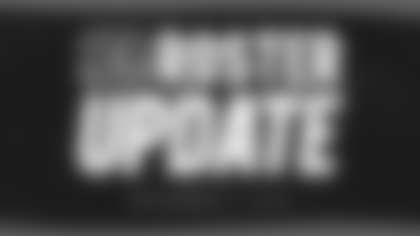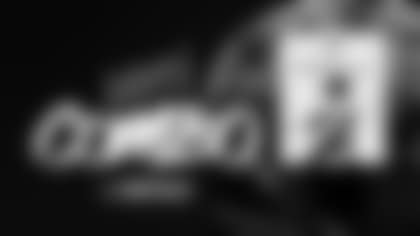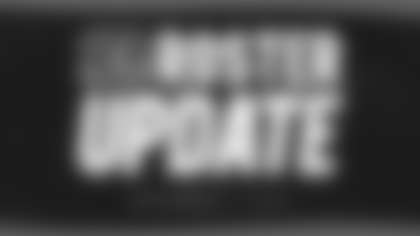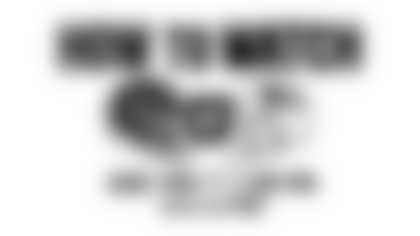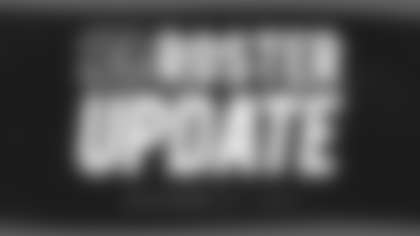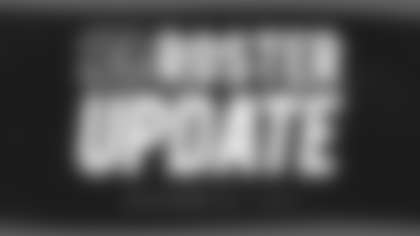Anthony Munoz, the greatest offensive lineman who ever lived, would join his linemates under the last snatches of shade before beginning a steamy training camp day at Wilmington College when they would see their coach walking to them on the way to crafting his own legend.
Often, offensive line coach Jim McNally would be followed by a gaggle of college or high school coaches looking to learn the intricacies of the rapidly changing position from the guru of modern line play. Munoz and the guys would then begin a low chant.
"Clinic. Clinic. Clinic."
Forty years later, Munoz is a Pro Football Hall-of-Famer, and McNally is joining him in Canton this week, where many of those linemates are traveling take part in another clinic to celebrate his selection as one of the Hall's award of excellence for assistant coaches.
And he's being followed by a lot more than a gaggle. Try a stream of about 24,000 following his instructions and tips on X.
McNally turns 82 on Dec. 13, 30 years after he last coached in Cincinnati and 18 years after he last coached an NFL line. But he's as relevant as the principles you'll see during another sweltering training camp when new Bengals offensive line coach and McNally disciple Scott Peters steps in with some familiar schemes.
"He's always been relevant, and always will be," says Peters, who had the best season of his seven in the NFL the one year he played for McNally and the 2003 New York Giants.
(The night the great Seattle tackle Walter Jones was announced as a Hall of Famer in 2014, he told Bengals.com how watching tapes while he was in high school of Munoz inspired him. Technique by McNally.
"That was the first thing my high school coach gave me. It was a VHS tape and Anthony Muñoz had a line drill on how to step, how to stay low. My coach made me watch that film every day. That's where I found the love of playing offensive line: from watching him. I was just thinking about that. There was no O-line video out there where O-linemen can show you how to play the game.")
Now, McNally has made the seamless move from tape to tweets.
"The information that he has is golden, and he touches on so many things that are highly detailed," Peters says. "A lot of NFL coaches follow him. They may not admit it, or they may not publicly announce or respond to things on (X). Knowing many people in this business, they're all following him and following it closely. But also the college coaches, and the youth coaches, and high school coaches. He's really trying to help everybody."
It's enough that McNally should invent the full-circle drill. After all, he's the innovator of such staples of offensive line play as "Duo," (a double-team play with no pulling guards) and the double-under technique, where instead of using your shoulders or your head, you use your hands and lock out your arms.
Now his protégé takes the job that vaulted McNally into the leadership of the O-line coaching fraternity. Back when he was a martial arts instructor, Peters attended the nationally acclaimed COOL clinic (Coaching Organization and Offensive Line) that McNally founded and brought to Cincinnati. "He just wanted to listen to guys over pizza, and they wanted to listen to him," says Peters of an event that mushroomed into auditoriums of 500.
"He's the best in the league," says McNally of Peters. "He knows the most about applying martial arts to real football. No other coaches can do it like he can. In 30 years, I got a lot smarter, and so did he along the way. A lot of stuff has changed."
But the one thing that hasn't changed in the trenches is the crusade of developing NFL linemen out of all sorts of shapes and sizes; all piles of metrics and mauling. It's what made McNally in Cincinnati and put him on X, and it's what the Bengals are banking on from Peters.
(When the Bengals line up next month, a rookie is projected to start at left guard, another rookie is projected to be the third tackle and a second-year player makes his first Opening Day start at right tackle.)
The players McNally teamed with Munoz on two Super Bowl offensive lines were largely late-round picks. Guard Bruce Reimers and center Bruce Kozerski, pillars of the Bengals O-lines that won back-to-back NFL rushing titles in the late '80s, would have been college free agents today. Joe Walter, a Pro Bowl-level right tackle, would have been taken in the last round.
"The time that he puts in, the detail, and just all about technique," says Munoz of McNally's greatness. "But there are a lot of coaches that just want you to block people, but his thing would be to teach you how and why, and he taught you. When we came off the field, we knew why things didn't go right because of the way we were taught."
Munoz laughs when he's watching a game and he hears the announcers chirping about those obligatory "half-time adjustments."
"Our adjustments were like that after each series, and that's the way he taught us," Munoz says. "He taught us to look at the linebackers in the secondary, and it wasn't just pay attention to the guy across from you, but I think the big thing was the technical part of the game. The technique."
Peters, who worked under one of the earliest McNally proteges in Bill Callahan during his stint in Cleveland, sees himself in the mold as his mentor when it comes to development.
"That's definitely what we focus on the most. We want to make sure guys are equipped," Peters says. "Because everybody gets drafted. They go with their separate team. Some guys have the same level of talent that others do, but they don't perform as well. And what is the difference? A number of different factors.
"You want to be in position to win even against guys that are able to overpower you, or have more athleticism. And those types of things. Jim always had answers for the players, and that was something that really inspired me as well … I think anybody can point out when you fail as a blocker. It's the real coach who can teach the player how to improve upon the performance, and how to give him the tools so he can be successful. Not just point out a flaw. And I think that's what Jim did really well."
McNally worked as a Bengals consultant for several years up until a few seasons ago. During that run, he bumped into undrafted free agent tackle Devin Cochran in the team hotel lobby during training camp and offered the 6-7, 310-pounder encouragement.
Clearly bright and resourceful as a product of Vanderbilt and Georgia Tech, Cochran is McNally's kind of guy. In the next offseason, Cochran went to where McNally lives in Buffalo and spent two days watching tape and technique. After a three-year climb, Cochran came off the bench to play his first NFL ball in the five-game winning streak that ended last season.
"Great kid. Really smart," says McNally, who is McNally because he takes as much pleasure working with a Hall of Famer as he does a CFA.
Cochran from a 2024 Bengals.com story: "Dude, he's a maniac. You ever see him do pullups? … He's big on fast feet, fast hands, proactive hands. Taking the fight to the defender … "Eliminating time and space."
McNally is just as famous for putting his workouts on X as he is for those videos where he's lining up chairs to block.
How many pullups?
"Fifteen in a row," McNally says.
If he sounds a bit unique, no one would argue.
"I don't know anybody quite like him. And I mean that in the best way possible. He's unique in every way," Peters says. "And I think he's so passionate about what he does, he's so dialed into it, obsessed about it. And the thing that's great is he keeps it light. He keeps it fun."
Munoz, who worked with Peters a bit in Cleveland, got involved with him here quickly. He came down to Paycor Stadium this spring and met with head coach Zac Taylor for a bit before visiting Peters in his room. He's looking forward to seeing some familiar moves and principles.
It's like he told someone in town who sent him a video of how great the Lions were running the ball last year. Anthony, the guy wrote breathlessly, they're doing things we've never seen before.
"Let me tell you something," Munoz wrote back. "First of all, the Lions run it extremely well. But they're running the zone blocking scheme that Jim McNally and Howard Mudd taught us in the early '80s that we ran our whole career in Cincinnati. But they do it extremely well. They're physical with their double team. One of the double teams comes out for the second level. They get moving, but it's been around for years."
At least ever since those last shards of shade disappeared in Wilmington four decades ago.
"You know what that proves?' asked Munoz when he heard of young Cochran's trip to Buffalo. "Offensive linemen are supposed to be smart.
"He's smart. He went to the greatest there is," says Munoz, who knows something about it.




